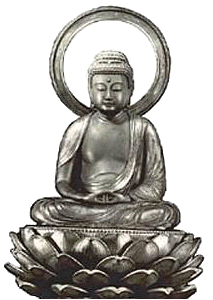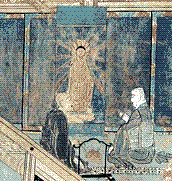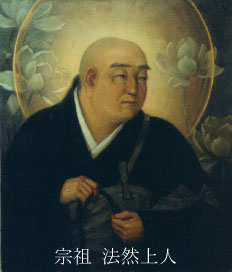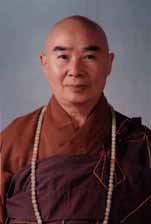




 Pure
Land Sutras : 1)
Pure
Land Sutras : 1)1) Amitabha
Sutra 2) Visualization
of Amitabha Sutra 3) Infinite
life Sutra
Dedication of merit ( after prayer or done good deeds )May the merit and virtues
accrued from this work
Adorn the Buddha's Pure Land,
Repaying the four kinds
of kindness above,
and relieving the sufferings of those in the Three Paths below.


 Venerable Honen Monk From Japan,
Venerable Honen Monk From Japan,
![]()

![]() Venerable
Chin Kung famous in Taiwan and Around Asian Countries
Venerable
Chin Kung famous in Taiwan and Around Asian Countries
translated by Hisao Inagaki
Our human body, if closely observed, is a bubble on water;
When the bubble bursts, the body ceases to be.
Our human life, if carefully pondered, is like an image of the moon
in water;
It does not remain unchanged while we breathe in and out. (1)
Those bodies in the good realms of devas and humans,
However deeply we may be attached to them, must die in the end.
Suffering in hell or in the realms of hungry spirits and animals,
However hard we may struggle to avoid it, easily comes back to afflict
us. (2)
Things before the eyes
Cannot be seen by the blind;
Words uttered near the ears
Cannot be heard by the deaf. (3)
We can smell and taste with our senses
Only for a short while;
When our breathing stops,
No perception remains in the body. (4)
From the distant past
Until today
Nothing wished for has become reality.
How sad! (5)
Those who believe that they are enlightened
In the teachings of the Path of Sages and the Pure Land Path
Have inexhaustible delusory thoughts regarding Samsara,
Which produce karma binding them to cycles of birth-and-death. (6)
Concerning the principle of non-duality of good and evil,
They think, with completely perverse views,
That right and wrong are indiscriminate.
How shameful their ignorance! (7)
Hearing that evil passions are identical with Bodhi,
They are too willing to commit evil karma,
But while recognizing that birth-and-death is Nirvana,
They are deeply attached to their own lives. (8)
The Pure Dharma-body in one's nature
Is the everlasting Buddha of True Suchness;
Since neither enlightenment nor delusion can be attributed to him,
What difference does it make whether we know or do not know this? (9)
The Reward-body fully glorified with the merits of a myriad practices
Is the Buddha in whom Reality and Wisdom are fused;
Since there is in him no subject-object distinction,
He is useless as the object of our mental and recitative Nembutsu.
(10)
The Accommodative Body attained by severing evils and practising good
Is the Buddha capable of curing illnesses by prescribing medicines
according to different
conditions,
But he cannot give the benefit of universal deliverance
To those who commit the ten evils and the five gravest offences. (11)
The Reward-body resulting from the Vow of the Nembutsu
Is the Buddha who brings ordinary beings to emancipation;
Since his Vow is for all beings in the ten directions,
No one is left outside of his salvation. (12)
The special Vow, unsurpassed in the whole world,
Has inconceivable power - the Other-Power;
So if one recites the Name aloud,
The evil karma of birth-and-death perishes as we voice the Nembutsu.
(13)
Apart from the first utterance of the Nembutsu,
The last ten utterances are not possible;
Each Nembutsu repeated is the first utterance,
And the last is the one uttered at the end of life. (14)
When discriminative thoughts are exhausted,
There is no beginning nor end to the Nembutsu;
The Buddha and sentient beings merging into one,
One should simply say "Namu Amida Butsu." (15)
Quickly abandon all secular engagements,
And entrust yourself to Amida with singleness of heart;
When your breathing stops with the Nembutsu,
That is the time when your mind ceases to function. (16)
At that time, from the Land of Utmost Bliss Amida, Kannon and Daiseishi
Appear before the devotee with a multitude of great sages,
As innumerable as the sands of the River Ganges;
Together they extend their hands to the aspirant
To welcome him and take him in their embrace. (17)
At that moment, he mounts a gold lotus seat
And follows closely after the Buddha;
In the lapse of a moment, he attain birth
In the Pure Land of Peace and Provision. (18)
The aspirant, having descended from the lotus seat,
Prostrates himself on the ground to worship the sages;
Following the bodhisattvas who guide him,
He finally reaches the Buddha. (19)
He makes a visit to the Grand Jewel Palace,
Where he listens to the Buddha's sermon;
He climbs up the tower among the jewelled trees,
Whence he looks out at distant worlds in other directions. (20)
After we have reached the Land of Peace and Provision,
We will return to the defiled world to save beings;
With the Vow of Compassion that knows no bounds,
We will repay his Benevolence for all ages in the future. (2)